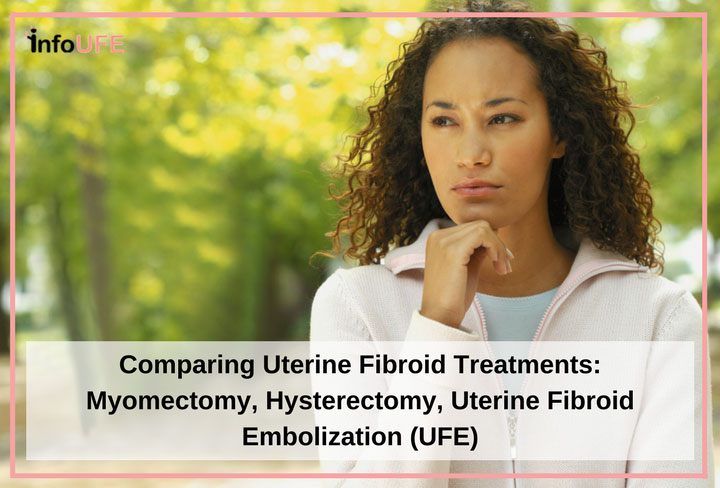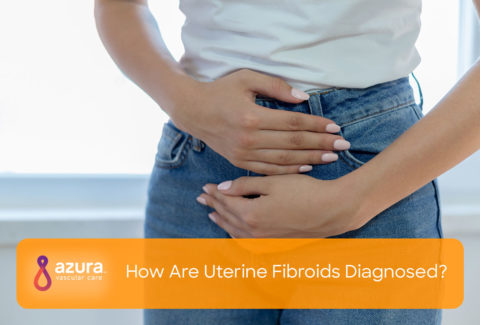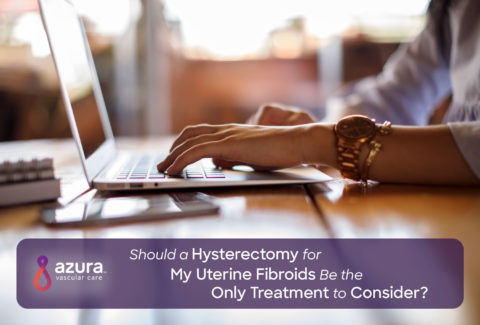
Are you considering surgery for the treatment of uterine fibroids? Are you aware of a minimally invasive alternative to uterine fibroid surgery?
Women diagnosed with uterine fibroids might be familiar with surgical options for treatment, including hysterectomy (surgery to remove the entire uterus), or myomectomy. For those looking for an alternative to hysterectomy, to preserve their uterus and to avoid surgery altogether, there is another choice to consider…a minimally invasive procedure known as uterine fibroid embolization (UFE).
Uterine fibroid embolization can performed in an outpatient setting by an interventional radiologist. UFE involves the placement of small beads within the blood vessels supplying the fibroid, blocking the blood supply and causing the fibroids to shrink. There are many differences between the three options for treatment, and the right choice depends on your individual case and goals.
Myomectomy vs Hysterectomy vs UFE
Myomectomy vs Hysterectomy
Myomectomy and hysterectomy are both surgical procedures to treat uterine fibroids.
A myomectomy procedure is designed to preserve the uterus. It is done through an incision, or in some cases more than one incision, in the abdomen, laparoscopically, or hysteroscopically through the vagina and cervix.
Hysterectomy is major surgery involving complete removal of the uterus, with or without removal of the cervix, ovaries, and fallopian tubes. Hysterectomy can be performed through a large incision in the abdomen, or laparoscopically through several small incisions using a camera and special surgical instruments.[i]
Benefits of Myomectomy Over Hysterectomy
Some women may prefer myomectomy over hysterectomy if they wish to preserve their uterus for future pregnancies, or, they may simply feel they are not ready to lose their uterus. The recovery time with myomectomy is generally 2-6 weeks, which is less than the 6 weeks needed to recover from hysterectomy.[i-ii]
Benefits of Hysterectomy Over Myomectomy
The biggest benefit of hysterectomy over myomectomy is that the uterine fibroids are cured. Because the uterus is removed, the fibroids cannot grow back. There is a risk after myomectomy that new fibroids can grow, and it’s important to point out that occasionally, not all of the fibroids may be able to be removed during myomectomy procedures.
UFE vs Hysterectomy
UFE is a minimally invasive procedure that is effective for treating uterine fibroids and is considered an alternative to uterine fibroid surgery removal. UFE is typically performed as an outpatient procedure, which means that most women go home the same day for recovery.
Benefits of UFE Over Hysterectomy
UFE has several benefits over hysterectomy. Besides involving only a small nick in the groin or wrist for catheter insertion, the uterus is preserved. There is no scar with UFE. For a UFE, conscious sedation is used, unlike for a hysterectomy, where the woman receives general anesthesia. The recovery time for UFE is generally within 2 weeks, which is significantly faster than the usual 6-week recovery time after hysterectomy.[i,iii]
Benefits of Hysterectomy Over UFE
The only real benefit to hysterectomy over UFE is that the uterus is removed and the fibroids cannot come back. In spite of the chance of regrowth, women seem to be just as satisfied with the results of UFE compared to hysterectomy after 5 years.[iv] For some women, it may not be the right time to remove their uterus.
UFE vs Myomectomy
UFE and myomectomy are appealing options to many women because, in both procedures, the uterus is preserved. Myomectomy involves cutting the fibroids out of the uterus, whereas UFE involves cutting off the blood supply and allowing the fibroids to shrink on their own.
Benefits of UFE Over Myomectomy
UFE may be preferred over myomectomy because all of the fibroids can be treated at once. Not all fibroids may be able to be removed with myomectomy. Myomectomy also comes with a higher bleeding risk and potentially more time off of work and away from regular activities.[iii] Myomectomy may not always require general anesthesia, but it typically requires an overnight stay in the hospital.
Benefits of Myomectomy Over UFE
Myomectomy has some advantages over UFE. In myomectomy, the fibroids can be evaluated by a pathologist and confirmed that they are noncancerous. While the chance of these lesions turning out to be cancer after being evaluated with ultrasound and MRI prior to any procedure is very low, some women may be reassured by testing of the specimens.[v]
Myomectomy, hysterectomy, and UFE all have advantages and disadvantages. If you are interested in pursuing the minimally invasive option, UFE, the next step is to request an appointment with an interventional radiologist. After reviewing your goals and medical history, this specialist will help you decide if UFE is the right choice for you.
Sources:
i http://www.acog.org/Patients/FAQs/Uterine-Fibroids
ii http://www.mayoclinic.org/tests-procedures/myomectomy/basics/what-you-can-expect/prc-20012919?mc_id=google&campaign=318207679&geo=9019549&kw=myomectomy&ad=75571036639&network=g&sitetarget=&adgroup=20828273959&extension=&target=kwd-126736462&matchtype=p&device=c&account=9153355657&placementsite=minnesota&gclid=CNXttrS6u8kCFRCNaQodey8M1w
iii Khan, A.T., Shehmar, M., and Gupta, J.K., Uterine fibroids: current perspectives. Int J Womens Health, 2014. 6: p. 95-114.
iv van der Kooij, S.M., et al., Uterine artery embolization vs hysterectomy in the treatment of symptomatic uterine fibroids: 5-year outcome from the randomized EMMY trial. Am J Obstet Gynecol, 2010. 203(2): p. 105 e1-13.
v Mara, M. and K. Kubinova, Embolization of uterine fibroids from the point of view of the gynecologist: pros and cons. Int J Womens Health, 2014. 6: p. 623-9.



